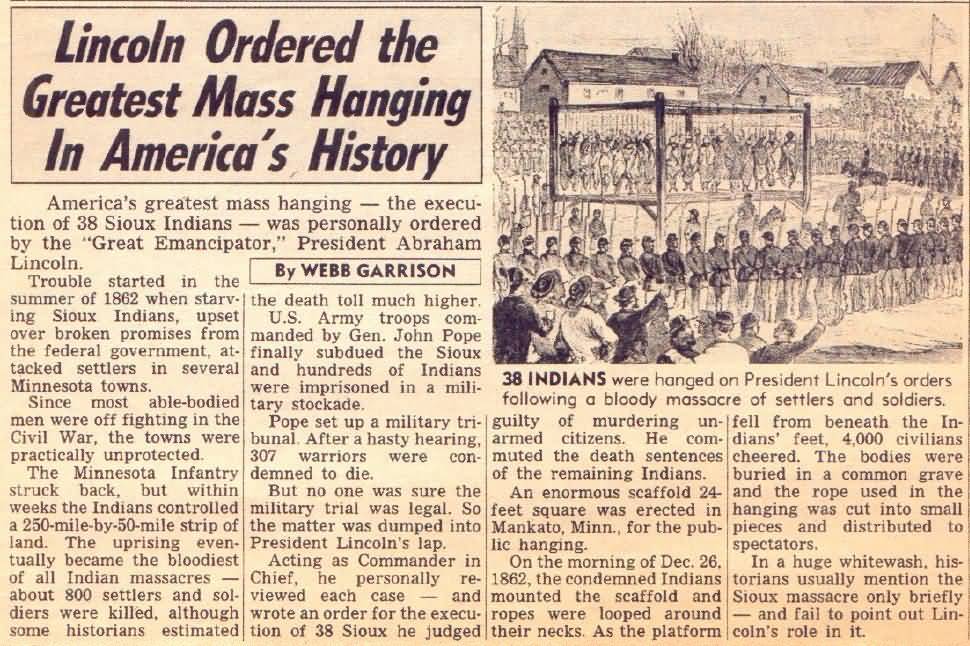Dakota 38 execution was the largest mass execution in the United States and took place on December 26th, 1862. On the day after Christmas in 1862, the United States president Abraham Lincoln ordered to hang the 38 Dakota men. These hangings were a result of the US-Dakota war which took place in 1862 in southwest Minnesota. There was a lot of injustice to other men in the form of military convictions and inhumane injustices were put forth on them. The people were held captive and were forced to march out of Minnesota.

Conspiracies
How It All Started?
The conflict erupted when the treaties made the Dakota people flood to an area that could no longer sustain them. The compensations were slow and sometimes non- existent. They feared starvation and were heading into harsh Dakota winter.
They also faced terrible racism. There were tense relations between the Dakota settlers and the white people and it led to war. 4 young Dakota hunters were credited with killing 5 settlers. The US-Dakota war of 1862 encompassed 37 days of fighting. There was a lot of fatalities and many people killed. Some of the people left with their families and other leaders surrendered to Sibley.
A military commission was set up and the panel would decide their punishment. The historians yet question whether a military commission was legitimate in cases of murder, rape, etc. All the people of the commission were involved in the war and hence the question of bias in handling those situations come out.
Lincoln gave the order for hanging 38 people and those were the people convicted of participating in civilian massacres. His decisions were based on convictions based on witnesses. One of the condemned men sent a letter to his father in law which angrily stated that he had not committed any crime but yet he was set apart for execution.
One of the professors of a law college didn’t approve of Lincoln’s actions and stated that he should have followed the general military practice at that time and they should have been released. He made a political decision based on racial discrimination and he is a lawyer knew it was not right.
Also Read: All You Need To Know About Steampunk Art
The Execution
The people did not know about their execution until December 22nd and they sang, danced and were allowed to meet their family members on 23rd December. At that time when convictions were being held out a massive wagon train of Dakota community and tribal members were attacked and it was said that a baby was snatched from a mother’s hand and was beaten to death.
At the location of the hanging, a crowd of men and women threw bricks and stones at the guards seriously injuring them. The hanging took place on 26th December 1862. It was believed that two men were killed by mistake and one was called by the name of ‘Chaske’ or first son that was misidentified and one white man named Dakota who had been acquitted had been hanged.
It was said that more than 4000 men were present at the hanging and they cheered when the people were hanged. After a while, the men’s bodies were cut down and hauled to a shallow mass grave on a sandbar. They were soon dug-up and was used by physicians as cadavers. Many prisoners were pardoned due to lack of evidence in the coming days. Some were taken to Iowa camp. They were put in prison for at least 4 years and when they were released most of them have suffered from diseases and many had died. Those who had survived were sent back to their families.
Internment
During this time the women and children of Dakota were held in an internment camp. The sanitation and health conditions were poor. The infectious disease struck the camp and many died due to poor conditions in the camp. US congress abolished the reservation, declared all previous treaties with Dakota null and void and expelled the people of Dakota out of Minnesota.
Also Read: Why You Should Give More Importance To Customer Onboarding Process?
Conclusion
The trials of Dakota were conducted unfairly. The evidence was sparse and the tribunal was biased. The defendants were unrepresented in unfamiliar proceedings conducted in a foreign language. 38 Dakota men were hung and they sang a famous Dakota song as white muslin covered their face. It was a sad fate for Dakota. The military commission nor the reviewing authorities recognized that they were dealing with the aftermath of a war.